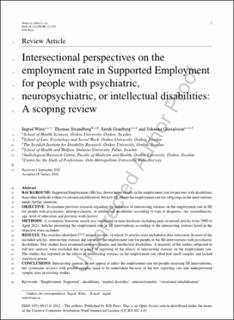| dc.contributor.author | Gustafsson, Johanna | |
| dc.contributor.author | Witte, Ingrid | |
| dc.contributor.author | Starndberg, Thomas | |
| dc.contributor.author | Granberg, Sarah | |
| dc.date.accessioned | 2023-04-14T13:19:48Z | |
| dc.date.available | 2023-04-14T13:19:48Z | |
| dc.date.created | 2023-01-31T10:57:52Z | |
| dc.date.issued | 2022 | |
| dc.identifier.citation | Work : A journal of Prevention, Assesment and rehabilitation. 2022, 1-20. | en_US |
| dc.identifier.issn | 1051-9815 | |
| dc.identifier.issn | 1875-9270 | |
| dc.identifier.uri | https://hdl.handle.net/11250/3063168 | |
| dc.description.abstract | Background: Supported Employment (SE) has shown better results in the employment rate for persons with disabilities than other methods within vocational rehabilitation, but how SE affects the employment rate for subgroups in the interventions needs further attention.
Objective: To examine previous research regarding the influence of intersecting statuses on the employment rate in SE for people with psychiatric, neuropsychiatric, or intellectual disabilities according to type of diagnosis, sex, race/ethnicity, age, level of education and previous work history.
Methods: A systematic literature search was conducted in nine databases including peer-reviewed articles from 2000 to April 2021. Articles presenting the employment rate in SE interventions according to the intersecting statuses listed in the objective were included.
Results: The searches identified 3777 unique records, of which 53 articles were included in data extraction. In most of the included articles, intersecting statuses did not affect the employment rate for people in the SE interventions with psychiatric disabilities. Few studies have examined neuropsychiatric and intellectual disabilities. A majority of the studies subjected to full-text analysis were excluded due to a lack of reporting of the effects of intersecting statuses on the employment rate. The studies that reported on the effects of intersecting statuses on the employment rate often had small samples and lacked statistical power.
Conclusions: Intersecting statuses do not appear to affect the employment rate for people receiving SE interventions, but systematic reviews with pooled samples need to be undertaken because of the low reporting rate and underpowered sample sizes in existing studies. | en_US |
| dc.language.iso | eng | en_US |
| dc.publisher | IOS Press | en_US |
| dc.relation.ispartofseries | Work : A journal of Prevention, Assesment and rehabilitation; | |
| dc.rights | Navngivelse 4.0 Internasjonal | * |
| dc.rights.uri | http://creativecommons.org/licenses/by/4.0/deed.no | * |
| dc.title | Intersectional perspectives on the employment rate in Supported Employment for people with psychiatric, neuropsychiatric, or intellectual disabilities: A scoping review | en_US |
| dc.type | Peer reviewed | en_US |
| dc.type | Journal article | en_US |
| dc.description.version | publishedVersion | en_US |
| cristin.ispublished | false | |
| cristin.fulltext | original | |
| cristin.qualitycode | 1 | |
| dc.identifier.doi | http://dx.doi.org/10.3233/WOR-211155 | |
| dc.identifier.cristin | 2119657 | |
| dc.source.journal | Work : A journal of Prevention, Assesment and rehabilitation | en_US |
| dc.source.pagenumber | 435-454 | en_US |

